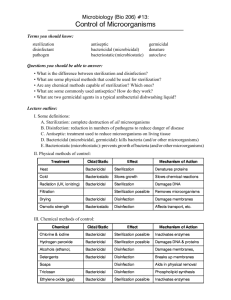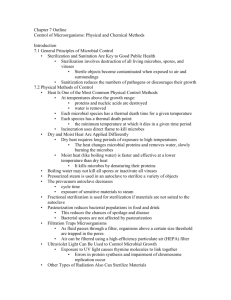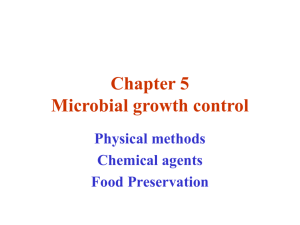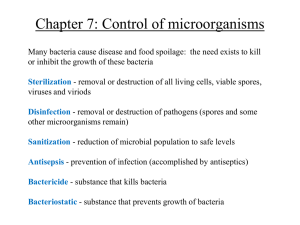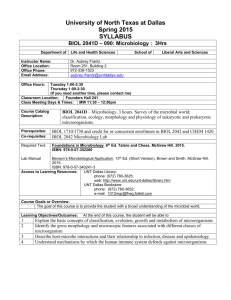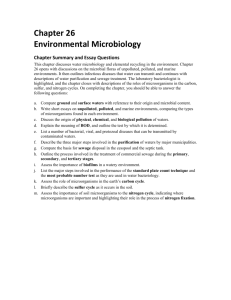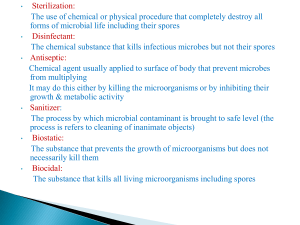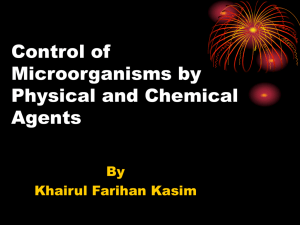microbial control methods
advertisement
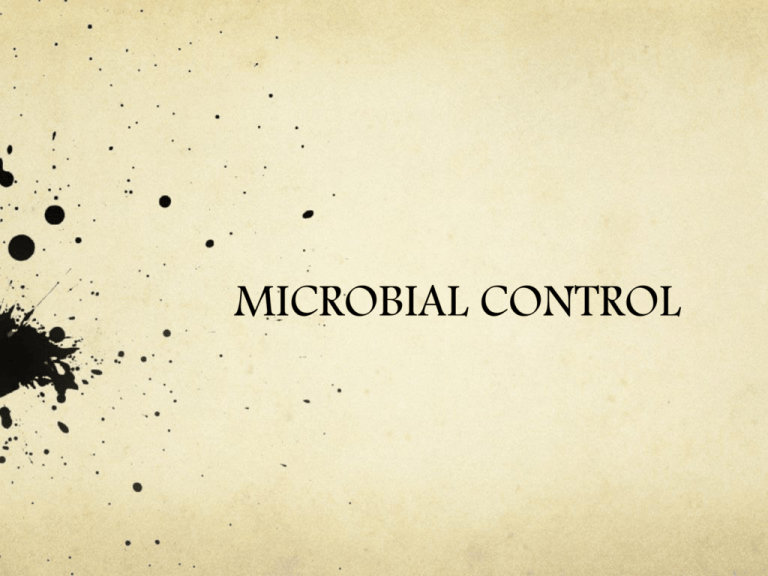
MICROBIAL CONTROL MICROBIAL CONTROL METHODS Physical Control Heat Cold/Dessication Radiation Autoclave Chemical Agents Categories of chemicals Household products (listed next page) HOUSEHOLD PRODUCTS CONTROLLING MICROORGANISMS Decontamination- the destruction, removal or reduction in number of undesirable microbes 4 methods of decontamination Sterilization Disinfection Sanitization Degermation STERILIZATION- Removal or destruction of all viable microbes Autoclaving, ionizing radiation DISINFECTION- Destruction of vegetative pathogens on an inanimate object 5% bleach, boiling water Disinfection does not usually kill bacterial spores whereas sterilization destroys all organisms. Difference between disinfection and sterilization? Disinfection is only a reduction of microbial load on an object. An object that has been disinfected is less likely to transmit infection than one that hasn't but because there is only a reduction in the number of microorganisms, there is no guarantee. Sterilization is absolute. It means that ALL of the microorganisms have either been removed or killed. A sterile object has NO viable microbial cells present. SANITIZATION is a cleansing technique that removes microorganisms and debris from inanimate objects Dishwashing, laundering clothes Sanitizing your toothbrush is important because bacteria can build up from daily use. DEGERMATION cleansing technique that removes microorganisms and debris from living tissue Alcohol wipes, surgical handscrub Here is a review of key concepts of hand hygiene…. Health care-associated infections affect hundreds of millions of patients worldwide every year. Infections lead to more serious illness, prolong hospital stays, induce long-term disabilities, add high costs to patients and their families, contribute to a massive, additional financial burden on the health-care system and, critically, often result in tragic loss of life. (WHO, 2009) PHYSICAL CONTROL HEAT RADIATION COLD/DESICCATION Some things to consider if using HEAT…… Can use moist heat or dry heat Practical Concerns in the Use of Heat: Thermal Death Measurements Thermal death time (TDT): the shortest length of time required to kill all test microbes at a specified temperature Thermal death point (TDP): the lowest temperature required to kill all microbes in a sample in 10 minutes Temperature and length of exposure must be considered Higher temperatures generally allow shorter exposure times; lower temperatures generally require longer exposure times COMMON MOIST HEAT METHODS: Nonpressurized steam Steam under pressure Boiling water Pasteurization COLD/DESSICATION The main benefit of cold treatment is the slow growth of cultures and microbes in food during processing and storage. Cold does not kill most microbes; freezing can actually preserve cultures Desiccation: dehydration of vegetative cells when directly exposed to normal room air Lyophilization: a combination of freezing and drying; used to preserve microorganisms and other cells in a viable state for many years RADIATION Radiation is energy emitted from atomic activities and dispersed at high velocity through matter or space Ionizing radiation (X rays, gamma rays, electron beams) Ionizes water to release hydroxide Damages DNA Non-ionizing radiation (UV, 260 nm) Damages DNA Microwaves kill by heat; not especially antimicrobial Many foods can be effectively sterilized by utilizing the penetrating power of ionizing radiation. AUTOCLAVE Here is an example of how to clean a tattoo machine with an autoclave http://www.youtube.com/ watch?v=huStW067jI&feature=related CHEMICAL AGENTS Chemicals are divided based on their level of effectiveness and the surfaces to which they are applied. Antiseptics: microbicidal agents harmless enough to be applied to the skin and mucous membrane; should not be taken internally. Alcohols, mercurials, silver nitrate, iodine solution, detergents. Disinfectants: agents that kill microorganisms, but not necessarily their spores, but are not safe for application to living tissues; they are used on inanimate objects such as tables, floors, utensils, etc. Hypochlorites, chlorine compounds, lye, copper sulfate, quaternary ammonium compounds, formaldehyde and phenolic compounds. CHEMICAL AGENTS CONT. Chemotherapeutic agents (synthetic antibiotics): antimicrobial agents of synthetic origin useful in the treatment of microbial or viral disease. These are examples: sulfonilamides, isoniazid, ethambutol, AZT, nalidixic acid and chloramphenicol. Antibiotics: antimicrobial agents produced by microorganisms that kill or inhibit other microorganisms These chemicals approach the ideal by having many of the following characteristics: broad spectrum, low toxicity, fact action, penetrating abilities, residual effects, stability, potency in organic matter and solubility. Works Cited Lowry, Doc. "Tattoo Machines & Guns : How to Clean a Tattoo Machine." YouTube Broadcast Yourself. 15 Nov. 2008. Expert Village. 1 Apr. 2011 <http://www.youtube.com/watch?v=huStW067-jI>. "Microbiology in the news." American Society for Microbiology. 30 Mar. 2011. 20 Apr. 2011 <http://www.asm.org/>. Talaro, Kathleen P., Marjorie Kelly. Cowan, and Barry Chess. Foundations in microbiology. Boston: McGraw-Hill, 2009. Todar, Kenneth. "Control of Microbial Growth." Online Textbook of Bacteriology. 24 Apr. 2011 <http://www.textbookofbacteriology.net/control.html>. United Kingdom. World Nuclear Association. London SW1Y 4JH. World Nuclear Association | Nuclear Power - a Sustainable Energy Resource. 1 Apr. 2011. 2 Apr. 2011 <http://www.world-nuclear.org/info/inf05.html>. "WHO | World Health Statistics 2009." World Health Statistics 2009. 2009. World Health Organization. 24 Mar. 2011 <http://www.who.int/whosis/whostat/2009/en/index.html>.



